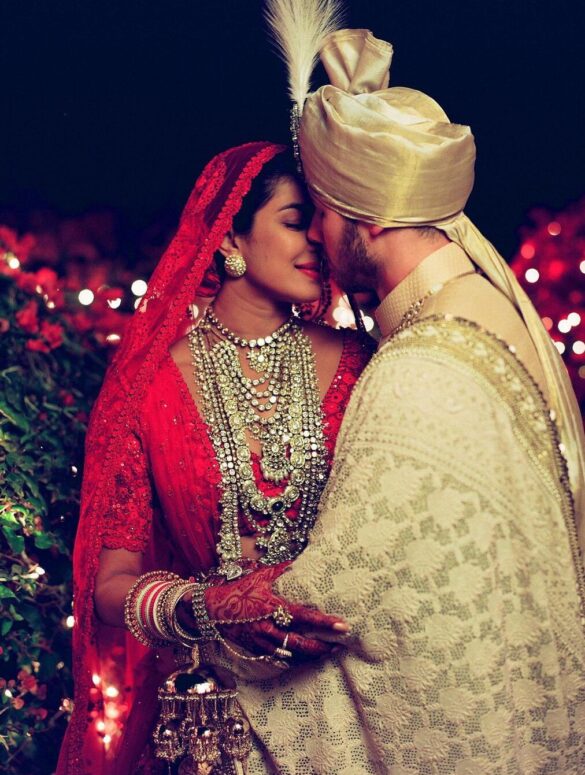Our world is a rich tapestry of traditions. These differences is what makes our world diverse and fascinating place to live in. This fact rings true when it comes to couples celebrating their love for each other, especially on their big day. If you have attended any wedding ceremony, regardless of the continent or country, you will know that the ceremony invariably comes attached with a plethora of rituals to bestow luck and prosperity to couples who are embarking on a new journey. These age-old traditions always honour the culture of the community, and most times, translate some interesting and logical thought-process behind each one of the customs. Above all, these practices offer an easy glimpse into milestone events and express deep emotions of the people and the place.
When you think of India alone, these nuances further get bifurcated into the religion and caste of the couple. For instance, the rituals at a South Indian wedding will be very different from a Punjabi wedding. There are, however, several common ones such as an astrology approved wedding date, multiple pre-wedding as well as post-wedding events, multiple outfit changes with an almost set dress code, the bridal reveal, lots of dancing and the groom’s baraat among many others still prevail at most celebrations.
At a global scale, tossing the bouquet, cutting the cake, the first kiss and wearing something old, borrowed and blue seem commonplace for the walk down the aisle. But just like how every love story is unique, matrimonial rituals around the world are just as unique. The common thread is the idea of celebrating the union of two individuals and love.
Ahead, we explore some of the most fascinating wedding traditions from around the world. While we can wrap our heads around a few of these bizarre traditions, they surely put a smile on our face and made you fall in love with weddings all over again. Keep reading to find out.
1. Germany: The bride and groom use chainsaws
German newlyweds indulge in a tradition known as Baumstamm Sägen, where the couple is expected to saw a log into two pieces. As it’s a task to be carried out by two people, Baumstamm Sägen symbolises the couple’s strength as they face challenges in their marriage.
2. Romania: The bride is kidnapped
In Romania, if the brides disappears before the wedding it doesn’t mean she has cold feet. On the contrary, it is a tradition for the bride to be “kidnapped” by friends and family before the wedding. Just like role-play, to get the bride back, the groom has to pay her ransom. It could be through romantic gestures or filling her glass with champagne.
3. Italy: Nuts are given to newlyweds
Many of us think of confetti as colourful bits of paper, however, in Italian “confetti” actually refers to sugared almonds. Wedding guests receive these as favours at the reception and they are used to be thrown at the bride and groom. But now they have been replaced by coriandoli aka the tiny scraps of paper.
4. Kenya: Father spits on the bride
If you go to a wedding in Kenya, don’t be shocked if you see the father of the bride spitting on her dress for good luck. For the Maasai people in Kenya, spitting on someone is seen as a show of respect. Hoping not to jinx the marriage, the spit is meant in good faith.
5. India: The groom gets his shoes stolen
In a traditional Hindu wedding, it’s a custom for the groom to remove his shoes before sitting for the pheras. It is during this time that the tradition of Joota Chupai takes place. It is a ritual where the bride’s bridesmaids and cousins often play a trick on him by stealing the shoes and hiding them. In order to get his shoes back, the groom must bribe the women with cash to return them before the ceremony ends.
6. China: The bride practices a crying ritual
While shedding a few tears at a wedding ceremony is common everywhere, in some parts of China, the bride is required to practice crying. A month before the ceremony, Tujia brides are expected to cry for one hour each day. Ten days into the ritual, she is joined by her mother, and ten days after, the bride’s grandmother joins in too. Known as Zuo Tang in the western Sichuan province, the ritual dates back to China’s Warring States era when the mother of a Zhao princess broke down in tears at her wedding.
7. Japan: Families drink in sync
Drinking wine at a wedding doesn’t sound too bizarre, however in Japan, the historic tradition of san-san-kudo requires the family to drink in sync. First the bride and groom take three sips each from three flat sake cups, after which their parents do the same, bonding the families together.
8. Korea: The bride is given a goose
Most newlyweds are gifted accessories for their new home or money to begin their new life together, however in Korea, brides and grooms exchange wooden geese and ducks on their wedding day as a sign of their commitment. Historically, grooms also give their new mother-in-law’s wild geese or ducks. The monogamous animals represent the groom’s pure intentions and loyalty to his bride.
9. South Korea: The groom’s feet are beaten
In parts of South Korea, grooms cannot leave with their new wives until they’ve had their feet beaten. After the ceremony, groomsmen or family members remove the groom’s shoes and bind his ankles with rope before taking turns to beat his feet with a stick, or in some cases, a dried fish. Thankfully, the ritual doesn’t last long and is seen as a fun part of the day that’s meant to test the groom’s strength and character.
10. Malaysia: The bride and groom are banned from the bathroom
Members of Malaysia and Indonesia’s Tidong people in Borneo observe a tradition that states the bride and groom must not leave their home or use the bathroom for three whole days after their wedding ceremony. They are kept under watchful guard and allowed only a small amount of food and drinks. Not observing the ritual is said to tarnish the bride and groom with bad luck often resulting in infidelity, the breakup of their marriage or the death of their children.
11. Venezuela: The newlyweds secretly leave the party
In Venezuela, it is tradition for the newly married couple to sneak off from their wedding reception without saying goodbye to their guests. Interestingly, it is believed that this tradition brings good luck.
12. Peru: Single ladies seek love in the cake
All single ladies, you’ll love this wedding tradition in Peru. A traditional Peruvian wedding cake has ribbons hanging out around the sides. Each ribbon is attached to a charm inside the cake; however one special ribbon is attached to a replica wedding ring. If you’re served the wedding ring-filled slice of cake, Peruvian’s believe that you’re next in line to get married.
13. Cuba: The bride charges you to dance with her
It is usually common for the bride to dance with her guests regardless of culture, however, in Cuba the dance comes with a price. Every man who dances with the bride is required to pin money onto her dress. This is done with the vision to help the couple pay for the wedding and honeymoon.
14. Australia: Guests are given special stones to hold
An Australian wedding ceremony might feature the tradition of a unity bowl. Upon arrival, guests are given stones which they are required to hold during the ceremony. When it’s over, guests then place the stones in a decorative bowl that the couple keep on display in their home, paying tribute to their friends and family who attended.
15. Fiji: The proposal involves a whale tooth
In Fiji, the groom and his family will often present the bride’s father with a sperm whale’s tooth when he asks permission. Though this practice is more common in rural areas, it’s practiced all over Fiji. The tooth, known as a tabua, translates to “sacred” in Fijian.
16. Norway: The bride wears crowns to ward off evil spirits
According to one popular Norwegian tradition, the bride must wear an ornate silver and gold crown that are encrusted with small charms. The tinkling sounds the charms make when she moves around will deflect evil spirit away.
17. Mexico: The couple wears a wedding lasso
Much like Indian couples wear floral haars for varmala, during a Mexican wedding ceremony, a long lazo or lasso is draped around the couple. This is often made with rosary beads and placed as the shape of the figure eight to signify the union and infinity symbol.
18. Congo: No smiling on the wedding day
Among the many unusual wedding customs, this one from the African continent may top the list. Despite the excitement and happiness that circle around the special occasion, Congolese couples are expected not to smile. If they do, it denotes they aren’t serious about marriage.
19. Lebanon: Dancing before the ceremony
Another wedding custom that may hit home is the one that hails from Lebanon. On the big day, the wedding celebration, known as the Zaffe, gets off to a playful start with music, belly dancing, and shouting at both the groom’s and bride’s homes courtesy of the couple’s friends, family, and, occasionally, professional dancers and musicians.
20. Czech Republic: Putting a baby on the couple’s bed
Before a Czech couple tie the knot, an infant is placed on the couple’s bed. This custom is done to relay blessings and enhance the couple’s fertility. Post ceremony, the guests shower them with rice to further promote fertility.













